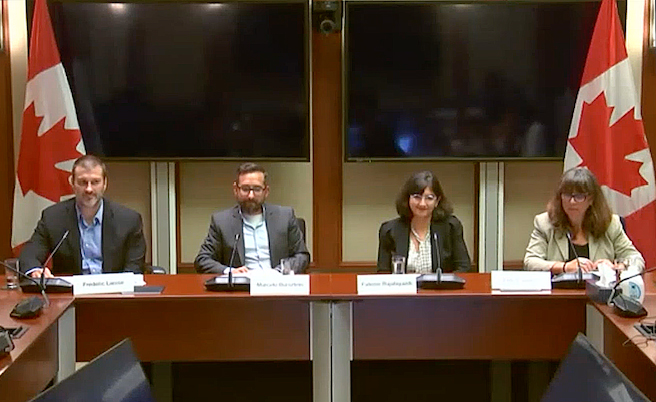As security professionals strive to efficiently analyze larger sets of data like never before, Novacene’s Marcelo Bursztein and Dr. Fateme Rajabi recently offered solutions through machine learning and data visualization.
Security professionals carry the weight of our safety on their shoulders, and they need tools that can help them do their jobs more effectively: that’s where AI can come in and help carry the weight.
This past fall, Government of Canada security specialists, across all levels, attended the Privy Council Office’s Security Centre of Excellence Speaker Series where they learned how AI and data visualization can offer greater efficiency and help facilitate complex problem-solving in their work.
Novacene CEO and founder Marcelo Bursztein, along with computer science professor Dr. Fateme Rajabi, joined the speaker series’ panel of experts to explain how AI can help security professionals analyze text at scale – and, how it can also enable powerful tools like data visualization to help make sense of large amounts of data.
AI: Offering new options to security specialists
Security professionals, including those within the Government of Canada, need to stay up-to-date on the latest security trends or issues that are happening in their sector. Three times a year, the Privy Council Office hosts the Security Centre of Excellence Speaker Series where approximately 250-500 security specialists learn about different topics related to their community – for example fraud schemes, and technical surveillance countermeasures.
As a panelist in the fall series The Power of Analyzing Text at Scale Using Artificial Intelligence, Bursztein wanted attendees to learn that they have options when it comes to analyzing large amounts of text.
“Everyone working in the space knows that analyzing text is extremely labour intensive,” he explains, adding that analysts have to sift through and code large amounts of data; a task that can take days or weeks to complete depending on the amount of text to analyze.
And with every new project, they have to start again from scratch.
“The very nature of the work makes it impossible to reuse the same framework from one project to another, so this creates a very labour-intensive reality that lands on the analysis team. This is a major pain point,” he says.
Ever-growing data
Dr. Rajabi, a Novacene advisor and assistant professor at Carleton University’s Department of Systems and Computer Engineering, adds that professions like security specialists are dealing with larger amounts of data than ever before, and AI is a promising tool to help them in their work.
For example, social media text adds to the ever-growing amount of data that needs to be collected and analyzed.
“A decade or so ago, we didn’t have the ability to have this large data collected, and we were just dealing with much smaller amounts,” she says. “Now, we are having this explosion of data everywhere. It’s time to think about how to bring humans back in control.”
Overcoming challenges though machine learning and data visualization
At the event, the panelists discussed innovative ways that AI can help security specialists do their job and overcome these challenges. Bursztein discussed one of those ways: unsupervised machine learning.
This means that the AI doesn’t have to be trained to organize the data and produce results. Instead, it can take data and automatically organize the information – eliminating the need for somebody to train it, which is a process that can be very time-consuming.
“Unsupervised machine learning minimizes the effort that it takes to get results. It almost works out of the box with very minor configuration.” Bursztein says.
Dr. Rajabi also spoke about the value of data visualization in understanding and analyzing data.
“The message I wanted to convey was when we are using data visualization, it gives us the power to see more than what we are looking for,” she explains.
For example, she says a spreadsheet with rows and columns can help an analyst look at sums and averages, which are things they can expect to find. But when the data is made into a visual image, analysts can discover patterns, anomalies and trends that wouldn’t have been clear in a spreadsheet.
“It’s like combining the power of visualization, AI and machine learning,” Dr. Rajabi explains, adding that data visualization can also open doors to more opportunities for a data analyst. “We can even develop hypotheses by looking at data visually. It’s really hard to get an understanding of what the data is telling us. What is the message here? With visualization, we can effectively and quickly help people understand the data, and discover insights they didn’t know needed to be considered. A picture is worth a thousand words.”
Opening the “black box” of AI
Bursztein says that while people have heard of terms like artificial intelligence or big data, they don’t always know what they mean.
As a panelist, he wanted to “parse out the concept of AI” for the audience.
“One of the things I hope that they took away was to find ways to open up that black box, and look inside and understand,” he says, adding that he hopes he gave the audience a good starting point on where to look for AI tools that can help them in their work. “Once people understand, they can do their own research and learn more about what matters to them.”


